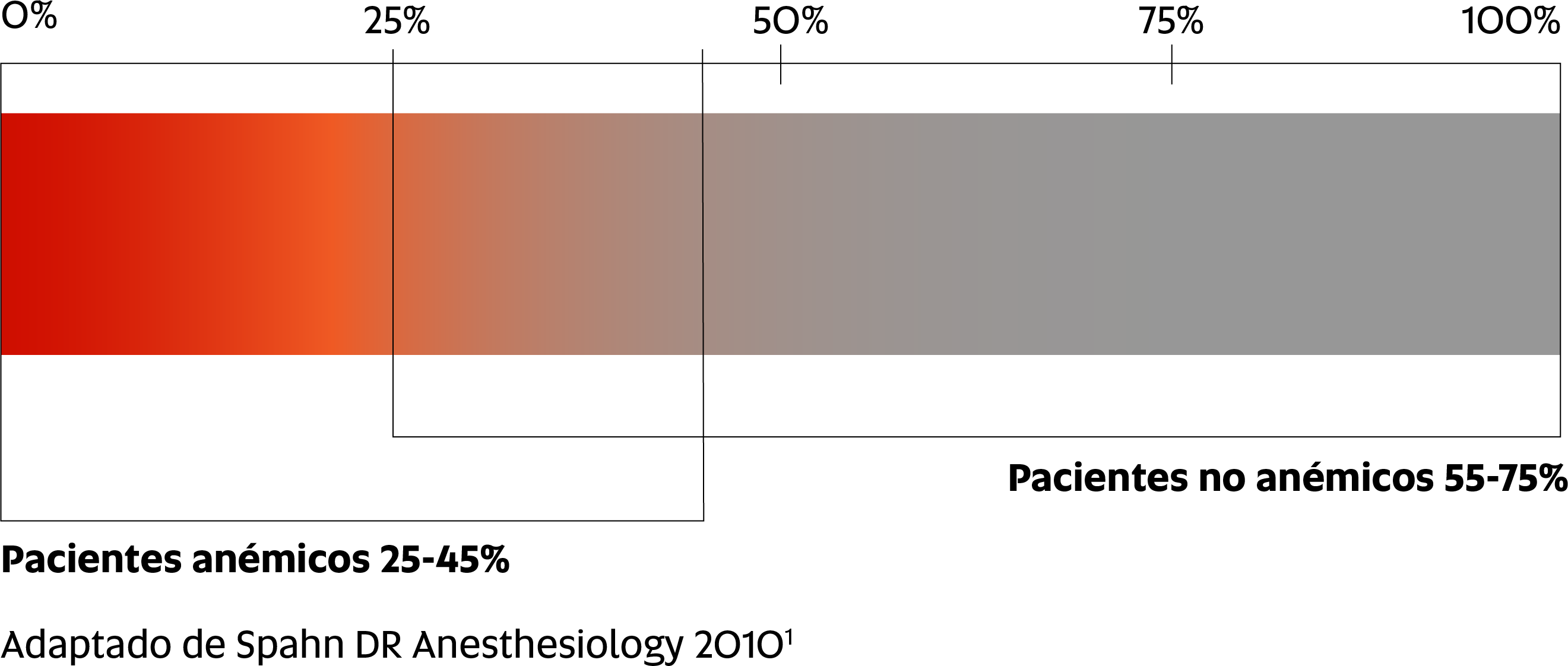Anemia pre-operatoria
DATOS SOBRE LA ANEMIA PREOPERATORIA
Prevalencia de la anemia preoperatoria:1
- La anemia preoperatoria es frecuente; 25-45% en cirugía de rodilla y cadera1
- El 90% de los pacientes con anemia preoperatoria no recibe tratamiento antes de someterse a procedimientos electivos, lo que se traduce en tasas de transfusión 3-4 veces superiores2

Efectos de la anemia preoperatoria en el pronóstico postoperatorio3, 4, 5, 6, 7, 8, 9
- Complicaciones más frecuentes y recuperación más tardía10
- El riesgo relativo de mortalidad aumenta en un 30-40% en la anemia leve, por lo que el grado de anemia se correlaciona directamente con el pronóstico10, 11, 12

CORRECCIÓN PREOPERATORIA DE LA ANEMIA Y EL DÉFICIT DE HIERRO
- Permite una movilización más rápida de los pacientes y estancias más cortas en el hospital9, 12, 13
- Reduce los costos14, 15
- La posible anemia debe investigarse 30 días antes del procedimiento y corregirse según sea necesario.
Por ejemplo:
- En cirugía de rodilla, cadera o columna vertebral, las necesidades medias de hierro preoperatorio en pacientes anémicos son de 1000 mg10
- Estas necesidades preoperatorias de hierro de 1000 mg pueden corregirse en 15 minutos con
1 dosis de Ferinject®15
Con la corrección preoperatoria de la anemia:
- se puede prevenir la anemia postoperatoria10
- el paciente se recupera más rápidamente9, 12, 13
- se puede reducir el número y el volumen de las transfusiones de sangre9, 12, 13
Antes de una intervención con una alta probabilidad de pérdida de sangre, también puede ser ventajoso aumentar las reservas de hierro del organismo.
Referencias
- Spahn DR. Anemia and patient blood management in hip and knee surgery. Anesthesiology 2010; 113: 482–495.
- Gombotz H et al. Patient blood management (part 1) – patient-specific concept to reduce and avoid anemia, blood loss and transfusion. Anaesthesiol Intensivmed Notfallmed Schmerzther 2011; 46: 396–401.
- Beris P et al. Perioperative anemia management: consensus statement on the role of intravenous iron. Br J Anaesth 2008; 100: 599–604.
- Beattie WS et al. Risk associated with preoperative anemia in non-cardiac surgery: a single-center cohort study. Anesthesiology 2009; 110: 574–581.
- Dunne JR et al. Perioperative anemia: an independent risk factor for infection, mortality, and resource utilization in surgery. J Surg Res 2002; 102: 237–244.
- Carson JL et al. Effect of anemia and cardiovascular disease on surgical mortality and morbidity. Lancet 1996; 348: 1055–1060.
- Gruson KI et al. The relationship between admission hemoglobin level and outcome after hip fracture. J Orthop Trauma 2002; 16: 39–44.
- Wu WC et al. Preoperative hematocrit levels and postoperative outcomes in older patients undergoing non-cardiac surgery. JAMA 2007; 297: 2481–2488.
- Mehra T, et al. Implementation of a patient blood management monitoring and feedback program significantly reduces transfusions and costs. Transfusion 2015; Dec;55(12):2807-15
- Theusinger OM et al. Patient blood management in orthopaedic surgery: a four-year follow-up of transfusion requirements and blood loss from 2008 to 2011 at the Balgrist University Hospital in Zurich, Switzerland. Blood Trans 2014; 12: 195–203.
- Musallam KM et al. Preoperative anaemia and postoperative outcomes in non-cardiac surgery: a retrospective cohort study. Lancet 2011; 378: 1396–1407.
- Kotze A, Carter LA, Scally AJ. Effect of a patient blood management programme on preoperative anaemia, transfusion rate, and outcome after primary hip or knee arthroplasty: a quality improvement cycle. Br J Anaesth 2012; 108: 943–952.
- Lawrence VA et al. Higher Hb level is associated with better early functional recovery after hip fracture repair. Transfusion 2003; 43: 1717–1722.
- Leahy MF et al. Improved outcomes and reduced costs associated with a health-system-wide patient blood management program: a retrospective observational study in four major adult tertiary-care hospitals. Transfusion. 2017; 57 (6): 1347–58.
- Mehra T et al. Implementation of a PBM monitoring and feedback program significantly reduces transfusions and costs. Transfusion. 2015; 55: 2807–2815.





